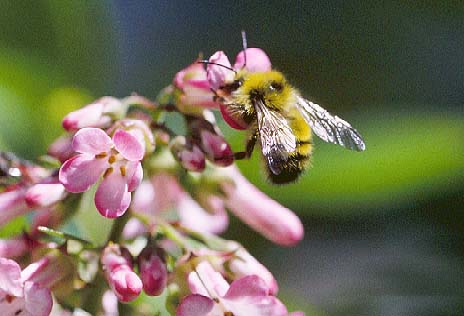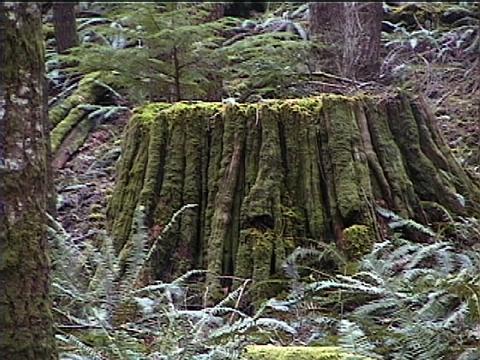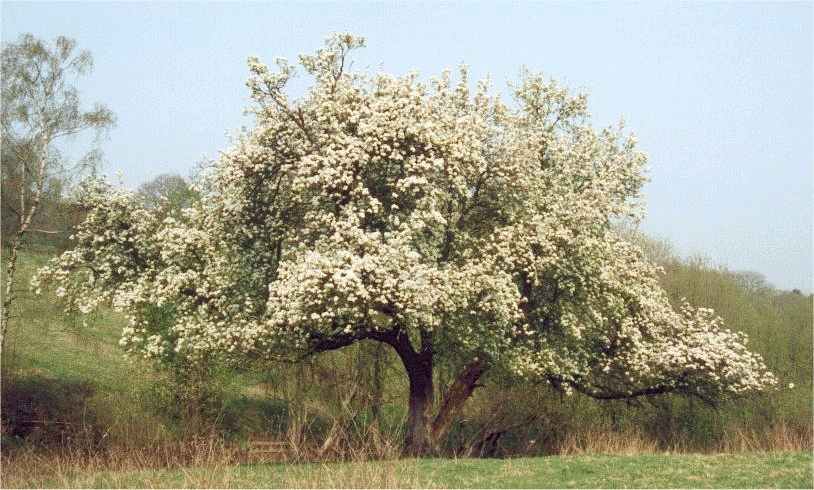|
Throughout
Their Eyes Were Watching God, Hurston employs the
symbolism of a pear tree – its mysteries and wonders – as a representation of Janie’s
questions, hopes, and aspirations. The tree embodies the roots of
her memories, the branches of her vision, and the blossoming of her
dreams. Rather than serving to describe the tree, the
anthropomorphisms granted to it
bespeak the essence of Janie, especially in contrast to the communities
around her. Those who are enslaved to man-made structures of
order,
such as the institution of and set reasons for marriage, are described
as dead trees. Dissimilarly, Janie, who yearns for more than the
acceptable norms of society, who is interested in her potentialities as
a human being throughout the spectrum of sexual to spiritual desires,
is
the true blossoming pear tree of the novel.

With “Janie saw her life like a great tree” (8), the second
chapter
of the novel introduces Janie’s empathy with nature to show her
relating
to the tree as a metaphor for her life. Having been conceived in
the woods to a mother named Leafy (19), it comes as no surprise that
the commencement of Janie’s conscious life (10) begins with this
empathy. At the age of 16, the “glossy leaves and bursting buds”
(11) of her own body mirror the “glistening leaf-buds” (10) of the tree
she so impassionedly sits beneath. The orgasmic epiphany she
experiences is awakened upon the stimulation her senses undergo in
hearing the “alto chant of the visiting bees, [and feeling the] the
gold of the sun and the panting breath of
the breeze” (11). Janie conceives of the concept of marriage
based
on the consummation of bees pollinating the pear tree blossoms and
tells
of her first wish, her first vision and dream; “Oh to be a pear tree
[…]
with kissing bees singing of the beginning of the world” (11).
She
yearns to be natural, for her life, most especially for her love life,
to
be at one with nature.
Her first sexual act is just that, following in the footsteps of the
pear tree. After observing nature and understanding the
applicability of
its metaphor to her life, Janie extends the metaphor by actualizing it
into
her own life. “Through pollinated air” (12), her mind having been
pollinated by those singing bees just like the air surrounding the
blossoms, Janie
receives her first kiss from a “beglamored” (12) Johnny Taylor.
It
is as though she "arches her calyx" to allow the dust bearing bee known
as
Johnny Taylor to "enter her sanctum" (11) in kissing her. Janie’s
first blossom has been set to bloom.
But, before she
can
bask in the glory of the physical and emotional sunlight that have
struck
her, Nanny rains on her parade. In clamping down on Janie to
curtail
her natural sexuality, forcing her to channel it only to societally
approved
marriage, Nanny proves herself to be the polar opposite of Janie,
represented
by the metaphor of a dead tree. “Nanny’s head and face looked
like
the standing roots of some old tree that had been torn away by storm”
(12).
The loss of life in her mirrored tree indicates the lack of vitality
and
vigor necessary to push forward, to want more than the societal
norms.
Although Janie has bound “cooling palma christi leaves” upon her head,
perhaps in hopes of restoring youth and its dreams within her, they
have
“wilted down” (12), just like those dreams. Nanny herself is on
the
brink of death saying “mah head is ole and tilted towards the grave”
(18),
wanting only to see Janie married right away to a “decent” man.
Upon
Janie’s protest, and pending Nanny’s guilt-eliciting response, Nanny
thrusts
“back the leaves from her face” (13), as if to assert enough vigor to
take
a stand, enough to slap her violently (14), but only enough to take a
stand
for the sake of societal norms. For example, Nanny accepts the
social
stratification as reality, saying “de white man is de ruler of
everything
as far as Ah been able tuh find out” (14), not seeking alternatives
beyond
the accepted. She similarly does not seek love for Janie, as made
clear
in her telling “’Taint Logan Killicks Ah wants you to have, baby, it’s
protection”
(15). Although Nanny herself refused to marry, out of fear of her
baby being mistreated after emancipation (19), indicating that in her
youth she may have blossomed, in her old age, her snarling branches
have
been dessicated of their idealism. Perhaps it is due to
witnessing
the demise of her raped daughter (19), that Nanny can no longer think
of
anything but safety. While Janie contends, “Ah wants things sweet
wid my marriage lak when you sit under a pear tree and think.
Ah…”
(24), according to Nanny, it is not happiness or love that will keep
her
safe, as Janie envisions under her pear tree, but a man, any man that
will
see to her physical security.


Janie’s intuition explored in this chapter foreshadows what is to
come. Logan’s sixty acres of financial security are “a lonesome
place like a stump in the middle of the woods where nobody had ever
been” (21-2), again continuing the symbolism of the tree. In this
case, the stasis of a stump is
in direct opposition to the flowery dreams and visions in Janie, which
become parched. Similarly, in her next marriage to Joe Starks,
although
Janie is hopeful that she would gain the “bee for her bloom” (32) with
him, she eventually finds herself confined to another stasis, that of a
high wooden porch stool where she “done nearly languished tuh death”
(114).
The stool, too, is of dead wood representing the descration of her pear
tree
the context implies. In not being given the opportunity to seek
out
her potential, in not being “petal-open with him” (71), she has “no
more
blossomy openings dusting pollen over her man, neither any glistening
young
fruit where the petals used to be” (72). Because Janie is
constrained
from actualizing her visions of the pear tree, which have become rooted
memories by this time, she feels her branches withering.

It is following the death of her second husband, and
more specifically
upon engaging with Tea Cake that Janie is finally granted the
opportunity
to actualize her girlhood dreams of blossoming. Tea Cake, whose
real name is appropriately Vergible Woods, is Janie's soul mate, both
of them being tree metaphors. He “could be a bee to a blossom – a
pear tree blossom in the spring” (106), in the eyes of Janie. His
nickname too holds significance in referring to something sweet, just
as she has hope dor "things swee wid mah marriage" (24). Because
Tea Cake is unconcerned with her money, for instance, in that he asks
her to keep her savings aside and live from his current earnings, Tea
Cake is clearly contrary to the norm of suitors who proceeded him
following the death of Mayor Starks, suitors who sought only her
money. He is a man truly in love with Janie, a man who
understands her. In instructing “Everytime Ah see uh patch uh
roses uh somethin’ over sportin’ they selves makin’ out they pretty, Ah
tell
‘em “ah want yuh to see mah Janie sometime.’ You must let de
flowers see yuh sometimes, heah Janie?” (181), he shows that he too
sees her mirroring, even competing with nature. It is with him,
that Janie is pollinated to realize the meaning of the pear tree’s
mysteries and wonders. By his side, she finds the answers to her
questions and realizes her hopes and aspirations. She becomes
confidant and proud of her stark contrast with the various communities
that surround her. In seeking out her potentialities as a human
being beyond the horizon of the societal norms, Janie blossoms.

|
|



